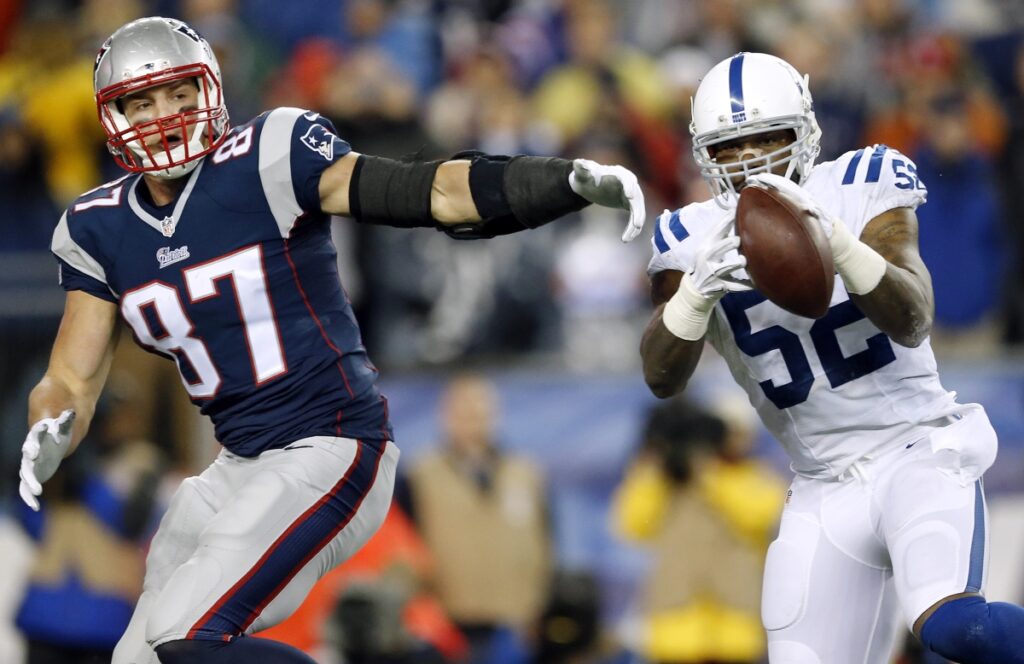Blowhards Feed Exaggeration of “Competitive Advantage”
After leading the Colts to a tough loss in the AFC Championship, the media found little to discuss beyond another Super Bowl journey for the formidable trio of Bill Belichick, Tom Brady, and company.
Once more? How unexciting. Who would even want to rehash that topic?
This sentiment resonated with many, as following their commanding victories over the Ravens and Colts, the Patriots find themselves on the verge of their sixth Super Bowl appearance since 2001.
Naturally, the scrutiny of football air pressure comes into play.
If you think this is a novel controversy, it may result from the selective public outrage that is either promoted or neglected.
Take, for instance, the transcript of Phil Simms openly discussing Aaron Rodgers possibly over-inflating footballs earlier this season. It’s not a call for any form of punishment but rather a mere observation that didn’t trigger an uproar. Hmm…
We are witnessing a modern-day dynasty unlike any in the annals of sports, and yet, will we shift our focus now?
Ten AFC East division titles, six conference championships, three Super Bowl victories…perhaps a fourth on the horizon?
It’s undeniably impressive! Nevertheless, instead of celebrating these monumental achievements, the nation is directed toward air pressure—or the alleged lack thereof—in last week’s game. The issue of ball pressure persists.

The primary question that arises in the mind of any discerning observer is: WHY?
This narrative traces its roots back to Spygate, an unquestionably genuine transgression. Upon assuming the head coaching role with the Jets, Eric Mangini divulges a little secret to the NFL, prompting an investigation.
The result? The Patriots were fined, and they forfeited some draft picks for illicitly recording the Jets’ signals during a game.
It was a clear cheating case, and consensus was swiftly reached. The issue was addressed and resolved, and the book was closed.
Now, let’s delve into these “deflated” footballs. Since Bill Belichick had a role in Spygate, the media promptly points fingers, connecting the reduced air pressure in a football to allegations of “cheating” and claims that this scenario confers a “competitive advantage,” and so on.
This notion of an “advantage” is one of this debate’s most misconstrued aspects. There are indeed advantages and disadvantages to altering the air pressure in footballs, so let’s explore them in detail:
Pros:
Enhanced Grip and Catching: Decreased air pressure in a football facilitates an improved grip, aiding quarterbacks in achieving greater accuracy when delivering passes.
The increased tactile sensation allows for better ball control, which is particularly valuable in adverse weather conditions where wind is a factor.
The softened ball texture also eases the burden on pass catchers, especially during frigid weather when numb hands make catching more challenging. It’s important to note that ‘easier’ doesn’t equate to ‘easy,’ as the task still requires skill and precision.
Glove Advantage: If one considers something unfair or even illegal, it should be the tackified gloves players wear.
These gloves possess an extraordinary stickiness, almost bordering on the unbelievable. Any dropped ball by a receiver wearing such gloves should be deemed more criminal than a penalty.
Of course, I jest, but in all seriousness, the influence of gloves in ball-catching far surpasses that of the air pressure in a ball.
Curiously, there is no clamor about preserving the integrity of the game when it comes to gloves while adjusting air pressure is seen as cheating.
Ball Grip and Breaking In: Quarterbacks usually take steps to break in footballs because they arrive with a natural slickness, requiring the removal of a film on their surface through brushing or other means.
A quarterback’s chief concern regarding game football is ensuring they have the proper grip.
Therefore, the principal rationale behind slight deflation is improving grip. However, why one adjustment is labeled ‘wrong’ while the other is not remains perplexing.
Cons:
Reduced Distance: Diminished air pressure translates to a decreased spinning trajectory and a shorter throw distance.
Consequently, it becomes more challenging to maintain accuracy when throwing over longer distances, creating a distinct disadvantage.
If the footballs were indeed deflated, it might help explain why a pass from Tom Brady toward Rob Gronkowski down the middle of the field ended up as an interception by D’qwell Jackson.
ESPN Sports Science has conducted a segment supporting this assertion of lost distance.
It seems to balance out, which might explain the collective indifference demonstrated by numerous former quarterbacks in the past day or so.
Drawbacks in other aspects of the game counterbalance any advantages gained. It’s also noteworthy that balls lose air pressure when exposed to cold temperatures.
While not insinuating that this was the case, I’ve often felt that footballs in a cold game have a slightly lower air pressure at the end of the game compared to the start.
Additionally, it’s not unprecedented for teams to modify footballs to suit their preferences.
Teams try to ensure that the footballs meet NFL regulations but are customized to each quarterback’s liking.
This can involve varying levels of tackiness, inflation preferences, and distinct adjustment methods. In most cases, the emphasis goes beyond ensuring a good grip on the ball, making other factors less significant for many players.

What’s most disheartening amid this entire discussion is the missed opportunity to celebrate the remarkable accomplishments and historical feats of Bill Belichick, Tom Brady, and the New England Patriots.
Instead, our attention is diverted to a subject that, in the grand scheme of the game, has a minimal impact.
Moreover, it’s perplexing that the finger of accusation is only pointed at the Patriots. Referees handle the football as frequently as anyone on the Patriots’ sidelines.
Suppose there indeed was an issue substantial enough to warrant this widespread outrage. In that case, it’s reasonable to expect that they would have noticed something amiss during the numerous occasions they interacted with the Patriots’ footballs in the first half.
It becomes increasingly implausible to believe they wouldn’t have observed anything if it was as severe as it’s been portrayed.
At this juncture, we lack substantial information regarding intent or the circumstances that led to the condition of these footballs.
We know that the overall impact of a slightly deflated football has been vastly exaggerated in the media. It’s a perspective that should be reconsidered and reframed.

